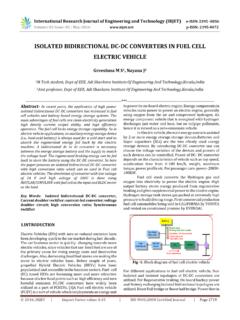Transcription of DESIGN OF COMPOSITE DECK SLAB
1 International Research Journal of Engineering and Technology (IRJET) e-ISSN: 2395 -0056 Volume: 03 Issue: 05 | May-2016 p-ISSN: 2395-0072 2016, IRJET | Impact Factor value: | ISO 9001:2008 Certified Journal | Page 100 DESIGN OF COMPOSITE DECK SLAB Kamal B 1, Alamelu G 2, Abinaya D 3 1 Assistant Professor, Department of Civil Engineering, Sri Ramakrishna Engineering College, Coimbatore 22. 2 Assistant Professor, Department of Civil Engineering, KTVR Knowledge Park for Engineering and Technology, Coimbatore 19 Final year Students, Department of Civil Engineering, Sona College of Technology, Salem 636005 ---------------------------------------- -----------------------------**--------- ---------------------------------------- --------------------Abstract - The aim of this project is to DESIGN the COMPOSITE slab which is connected using shear connectors.
2 The use of steel-concrete COMPOSITE construction has been widely applied in building construction (industrial buildings, Apartments etc). In general, COMPOSITE DESIGN provides the efficient use of material, ease of construction, time saving, and more space when compared with non- COMPOSITE DESIGN . The COMPOSITE slab which has to be placed on a conference hall has been selected for this project. In this project, the DESIGN of COMPOSITE slab and connection with the beam using shear connectors have been done using INSDAG DESIGN manual based on assumptions of Eurocode-4 and IS: 11384. The members are analyzed for the loads acting on them like live load and dead load. The necessary details of profile sheet and shear connectors were abstracted from Manufacturer s table recommended by INSDAG and IS: 11384.
3 The Detailed calculations for the DESIGN of COMPOSITE slab, steel beam and their connections are submitted in this project. Key Words: Keywords: Steel profile deck, Shear connectors, Construction stage and COMPOSITE stage 1. INTRODUCTION COMPOSITE DESIGN is when a structural member composed of two or more dissimilar materials joined together and acts as a unit. It is very economical way of speed up construction and important part of modern structural systems. The most important and most frequently encountered combination of construction materials is that of steel and concrete. These materials can be used in mixed structural systems as well as in COMPOSITE structures where members consisting of steel and concrete act together compositely.
4 These two materials are completely compatible and complementary to each other. They have almost the same thermal expansion. They have an ideal combination of strengths with the concrete efficient in compression and the steel in tension. Concrete gives corrosion protection and thermal insulation to the steel .It can restrain slender steel sections from local or lateral- torsional buckling. The steel - concrete COMPOSITE slab consists of rolled or built-up structural steel beams and cast in-situ concrete floors connected together using shear connectors in such a manner that they would act monolithically. The merit of steel-concrete COMPOSITE construction lies in the utilization of the compressive strength of concrete slabs in conjunction with steel beams, in order to enhance the strength and stiffness of the steel section.
5 COMPOSITE floors using profiled sheet decking became popular in high rise office buildings. COMPOSITE deck slabs are particularly competitive where the concrete floor has to be completed quickly and where medium level of fire protection to steel work is sufficient. There is presently no Indian standard covering the DESIGN of COMPOSITE floor systems using profiled sheeting. The structural behavior of these floors is similar to a reinforced concrete slab, with the steel sheeting acting as the tension reinforcement. Dovetail profile (Re-entrant) and Trapezoidal profile with web indentations are mostly used. Shear connectors or Mechanical connectors are used to develop the COMPOSITE action between steel beams and concrete.
6 This connection is provided mainly to resist longitudinal shear, and is referred to as the shear connection . The following mechanisms are widely applicable in COMPOSITE member DESIGN . 1. Natural bond between concrete and steel due to adhesion 2. Mechanical interlock provided by dimples on sheet, shear connectors Provision of end anchorage by shot fired pins or by welding studs when sheeting is made to rest on steel beams. 2. DESIGN METHODOLOGY Specifications The profile heights are in the range of 40-85 mm. Span between the beams are in the order of to m spans in excess of 4 m will require propping. The pitch of corrugations is between 150 mm and 350 mm. The span/depth values for continuous COMPOSITE slab should be less than depth of the COMPOSITE slab should not be less than 90 mm.
7 Thickness of concrete, hc , shall not be less than 50 mm. International Research Journal of Engineering and Technology (IRJET) e-ISSN: 2395 -0056 Volume: 03 Issue: 05 | May-2016 p-ISSN: 2395-0072 2016, IRJET | Impact Factor value: | ISO 9001:2008 Certified Journal | Page 101 DESIGN Situations The most important aspect of designer is to ensure an adequate degree of safety and serviceability of structure. The structure should therefore be checked for ultimate and serviceability limit states. In the DESIGN of COMPOSITE floors with profiled decking the following situations are considered.
8 Profiled Steel Sheeting as Shuttering (Construction stage) Verification is required for the profiled steel sheeting at the construction stage when it is acting as formwork for the wet concrete, construction loads and storage loads if any. While calculating the loads on the profiled sheet, increased depth of concrete due to deflection of the sheeting , ponding effect has to be considered. Account should be taken of the effect of props, if any. If the central deflection (d) of the profiled deck in non- COMPOSITE stage is less than l/325 or 20 mm, whichever is smaller, then the ponding effect may be ignored in the DESIGN of profiled deck. Profiled Steel Sheeting as Permanent Formwork ( COMPOSITE stage) Verification is required for the floor slab after COMPOSITE behavior has commenced and any props have been removed.
9 Total loading that is acting on the COMPOSITE slab is considered in the DESIGN checks for the ultimate Limit State. The loads are applied in such a way that the load combination is most unfavorable. 3. DESIGN OF COMPOSITE BEAM Data considered for DESIGN End Condition = simply supported Span of beam = 10m Distance between beam = Floor plan = 10m x Values Considered For DESIGN Imposed Load = kN/m2 (IS 875 part I) Partition Load = kN/m2 (PWD Standard) Floor finish Load = kN/m2 (PWD) Construction Load = (25 % of IL) Profile height =70 mm Section Taken for the DESIGN is ISMB 450. Self-weight of beam = kN/m2 (ISMB 450) Self-weight of slab = kN/m2 Fig -1.
10 Floor Plan DESIGN Load At construction stage = kN per m run At COMPOSITE stage = kN per m run Adequacy of the Section Bending Moment DESIGN Moment = kNm Moment of Resistance = kNm Lateral Buckling of steel Flange Maximum stress at the top flange of the section = N/mm2 Bending compressive stress in beam = N/mm2 Deflection Actual Deflection ( ) = mm Allowable deflection = mm Stress Total Stress in steel flange = N/mm2 Allowable stress in flange = N/mm2 DESIGN of Shear Connectors Total load carried by connectors = 2635 kN DESIGN strength of Shear connector considered = 57 kN (20 mm diameter & 100 mm height) Number of shear connectors = 48 / 5 m International Research Journal of Engineering and Technology (IRJET) e-ISSN: 2395 -0056 Volume: 03 Issue: 05 | May-2016 p-ISSN: 2395-0072 2016, IRJET | Impact Factor value: | ISO 9001:2008 Certified Journal | Page 102 Provide 2 connectors in a row with 200 mm c/c distance.












